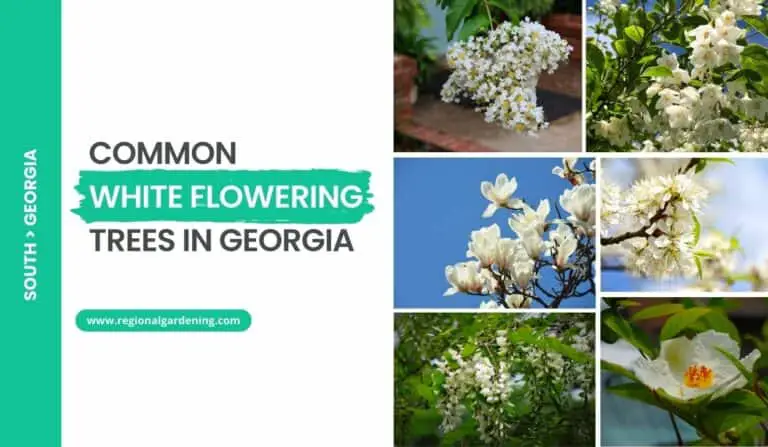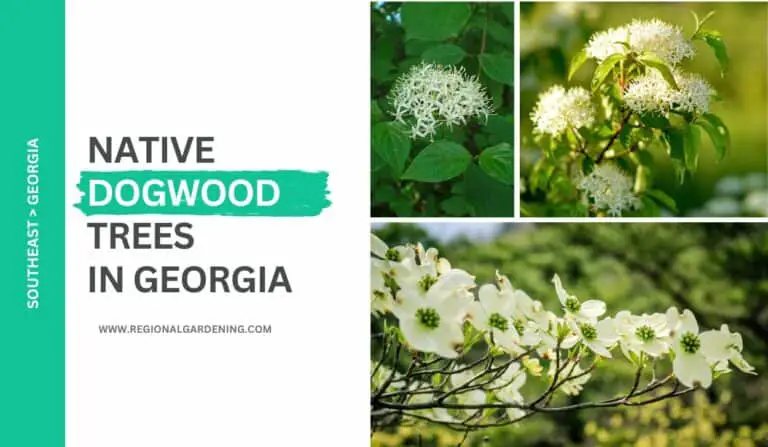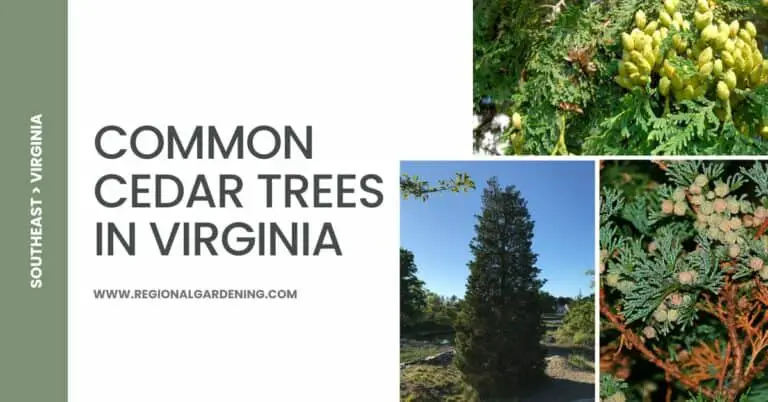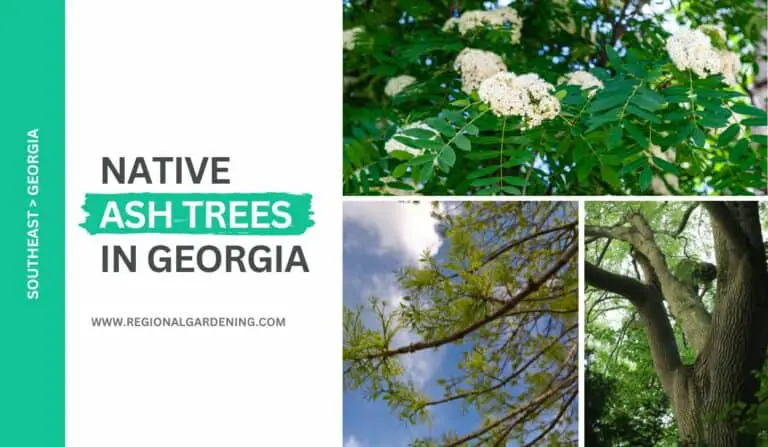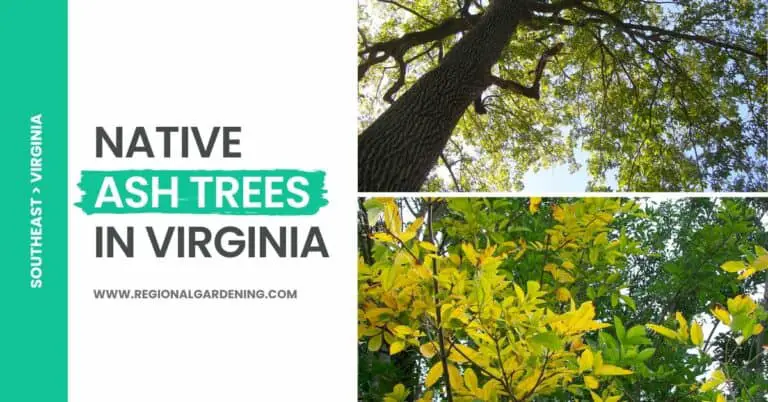5 Native Elm Trees In Oklahoma (Photos & Identification)
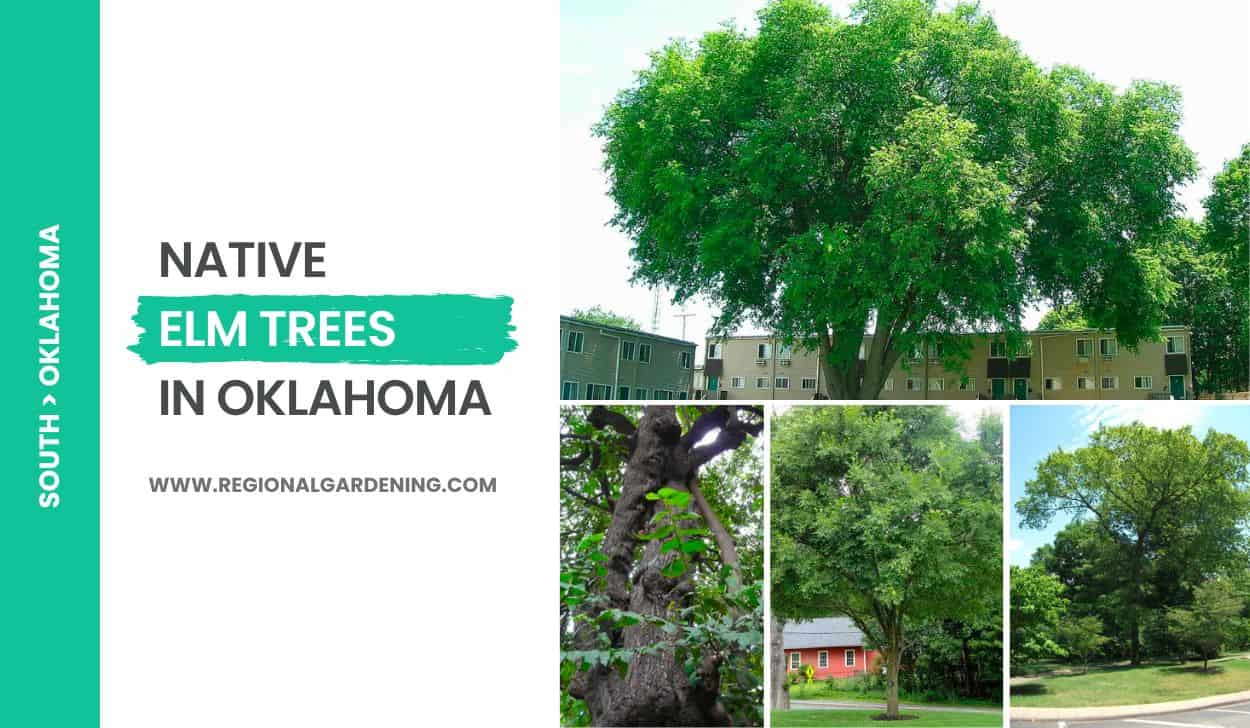
Elm trees in Oklahoma are a sight to behold, gracing the landscape with their majestic presence and vibrant foliage. These magnificent trees not only add natural beauty to parks, streets, and gardens, but they also provide numerous environmental and community benefits.
They improve our surroundings and serve as safe havens for local wildlife by providing shade and creating a peaceful ambiance. Furthermore, their versatile wood has historically been used in furniture production, making elm trees prized for their practicality and durability.
Let’s explore the wonderful world of elm trees in Oklahoma and learn about their many remarkable attributes.
1. American Elm
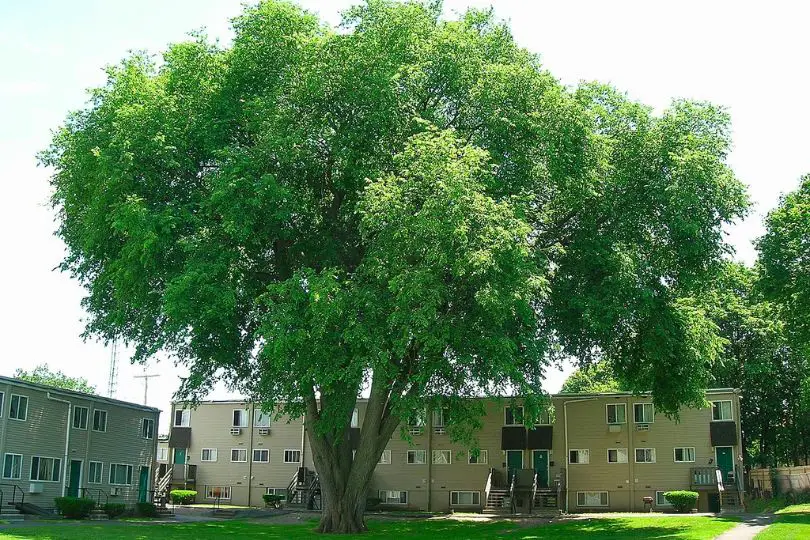
- Scientific Name: Ulmus americana L.
- Common Name(s): White Elm, American Elm
- Mature Height: 60 to 70 feet (18 to 21 meters)
- Native Region: Native to a vast area from New England to the Rocky Mountains and southward to Texas.
- Flowers: Small, perfect, greenish flowers appear before the leaves in early spring.
- Fruit: Light green, oval samara (winged fruit) with a distinctive deep notch in the wing.
- Uses: Commonly used for hubs of wheels, saddle trees, boats and ships, barrel hoops, and veneer for baskets and crates.
The White Elm is a tall deciduous tree that can reach a mature height of 60 to 70 feet. It is most common in New England, reaching through the Rocky Mountains and down to Texas. The White Elm’s bark is dark gray and separated into uneven, flat-topped, thick ridges. The bark of elderly trees may flake off in flakes.
The leaves are alternating, simple, 4 to 6 inches long, and toothed on both sides. They are thick and rather one-sided, smooth on top and downy on the bottom. The leaf veins are prominent and run parallel to the leaf edge from the midrib to the leaf edge.
The White Elm produces small, perfect, greenish blooms on short stalks in early spring. These blooms bloom before the leaves do. The White Elm fruit is an oval, light green samara (winged fruit) with a deep cleft in the wing. The fruit’s seed, which is located in the center, ripens in the spring and the wind widely disperses it.
White Elm wood is highly recognized for its strength and longevity. It’s big, hefty, tough, and difficult to split. This makes it suitable for a variety of uses, including wheel hubs, saddle trees, boats and ships, barrel hoops, and veneer for baskets and boxes.
Furthermore, because of its spreading fan-shaped appearance, attractive pendulous branches, and long life, the White Elm is a sought-after shade tree.
With proper care, the White Elm may thrive in Oklahoma environments. It is critical to provide the tree with well-draining soil as well as appropriate hydration. Regular watering during dry months is required to keep it healthy. Mulching around the tree’s base might help it retain moisture and protect its roots. To eliminate any dead or diseased branches, prune during the dormant season.
2. Slippery Elm
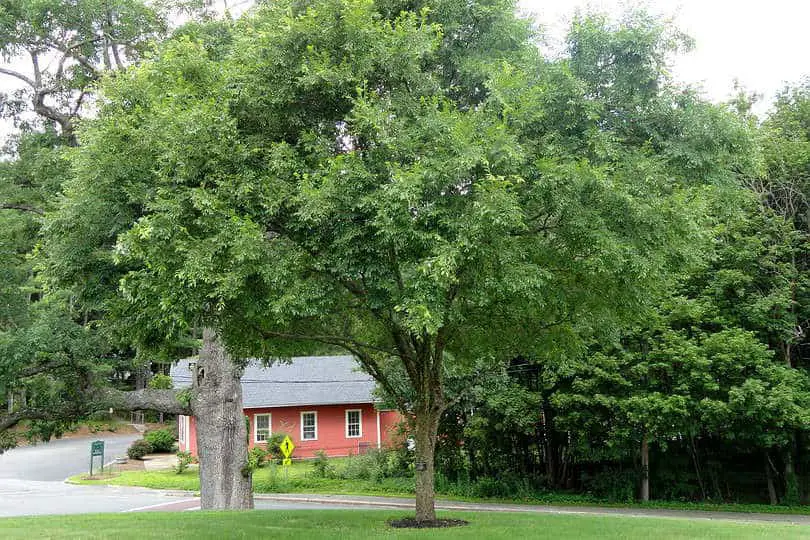
- Scientific Name: Ulmus fulva Michx.
- Common Name(s): Slippery Elm, Red Elm
- Mature Height: Usually less than 40 feet (12 meters)
- Native Region: Eastern and southern parts of Oklahoma, extending west to Comanche County.
- Flowers: Flowers appear in early spring, color not specified.
- Fruit: Thin, broad, greenish wings surrounding the seed, about half an inch (1.3 cm) in diameter.
- Uses: The inner bark is used for medicinal purposes; wood is used for fence posts, crossties, agricultural implements, and ribs for small boats.
The Slippery Elm, sometimes known as the Red Elm, is a small to medium-sized tree native to eastern and southern Oklahoma, with a range that extends west to Comanche County. It prefers rich soil and can be found beside streams and on low hillsides.
While the slippery elm isn’t a large tree, typically reaching less than 40 feet (12 meters) in height, it has a broad canopy that gives plenty of shade.
The bark of the slippery elm is distinctive, being approximately 1 inch (2.5 cm) thick on the trunk. Small fractures divide it into flat ridges, which are a dark grayish-brown color. Unlike other elms, the bark of the slippery elm does not have alternate brown and white layers when sliced.
The tree’s inner bark has a pleasant scent and, when bitten, creates a slippery mucilaginous material, giving the tree its common name.
The slippery elm’s leaves are simple and alternating on the stalk. They range in length from 4 to 6 inches (10 to 15 cm), are sharp-pointed, and have an asymmetrical base. The leaves have double-toothed edges, and the upper and bottom surfaces are rough and dark green.
The slippery elm blooms in early spring, though the particular color is not specified. A thin, wide, greenish wing that is about half an inch (1.3 cm) in diameter encloses the fruit’s seed. When the leaves are nearly half developed, the fruits ripen.
The slippery elm’s wood is highly appreciated for its properties. It is close-grained, robust, and strong, making it appropriate for a wide range of applications.
When in contact with soil, the wood becomes exceptionally heavy, hard, and relatively durable. As a result, it’s frequently used for fence posts, crossties, and agricultural tools. Slippery elm wood is also used to make ribs in small boats due to its strength and longevity.
The slippery elm is a prominent tree in Oklahoma due to its appealing look and functional usefulness. It is frequently planted in gardens and landscapes because of its broad canopy, which provides shade during hot summers. The tree’s inner bark has some medical properties and is occasionally harvested for traditional treatments.
Furthermore, the slippery elm’s strong wood is used in building and a variety of carpentry crafts. The slippery elm is a valuable addition to Oklahoma’s gardens and landscapes due to its adaptability to the state’s climate and numerous uses.
3. Cedar Elm
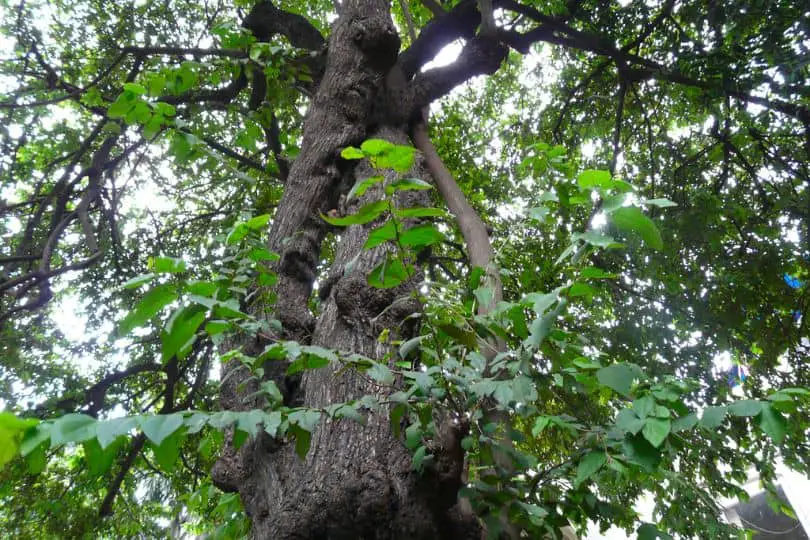
- Scientific Name: Ulmus crassifolia Nutt.
- Common Name(s): Cedar Elm
- Mature Height: Up to 75 feet (23 meters)
- Native Region: Southeastern part of Oklahoma, United States.
- Flowers: Small short-stalked clusters in axils of the leaves, appearing in autumn.
- Fruit: Oval-shaped samara, slightly over a quarter of an inch long, hairy all over, especially on the edges, and deeply notched at the tip.
- Uses: Wood is used for manufacturing hubs, furniture, and fencing. Often planted as a shade tree.
The Cedar Elm (Ulmus crassifolia Nutt.) is a deciduous tree native to southeastern Oklahoma. It thrives in regions near streams with deep, rich soil, as well as on arid limestone hills. This species can grow to be up to 75 feet tall, with a tall straight trunk measuring 2 to 3 feet in diameter. The tree has an elegant form with an inversely conic round-topped head and drooping branches.
Cedar Elm bark is light brown with a reddish tinge, highly fissured, and has flattened scaly ridges. The juvenile twigs are delicately velvety and crimson, with occasional thin corky wings.
This elm species has little leaves, with the largest reaching less than 2 inches long. They frequently have toothed borders and a blunt tip. The leaves are dark green and quite rough on the upper side, while the undersurface and leaf stem are hairy.
The Cedar Elm produces little short-stalked clusters of blooms in the axils of its leaves in the autumn. These blossoms offer a splash of color to the tree.
Following pollination, the tree produces oval-shaped samaras measuring slightly more than a quarter of an inch long. These samaras are hairy all around, especially on the edges, and the tip is deeply notched. The wind aids in the dispersal of Cedar Elm seeds.
Aside from its decorative beauty, the Cedar Elm has utilitarian applications. This tree’s wood is reddish-brown and brittle, with a thick coating of lighter-colored sapwood on top. It is occasionally used in the production of hubs, furniture, and fencing.
Furthermore, because of its aesthetic attractiveness and ability to give shade, it is frequently planted in Oklahoma gardens and landscapes.
It is critical to offer well-drained soil and ample sunlight to Cedar Elm in Oklahoma landscapes. It grows best in deep, rich soil near streams, but it can also survive in dry situations on limestone hills. During dry periods, regular irrigation is required, especially while the tree is young.
Pruning can assist keep its desired shape and eliminate any dead or unhealthy branches. Watering, fertilizing, and pest control procedures that ensure the tree’s overall health will help it grow and thrive in Oklahoma gardens.
4. Winged Elm
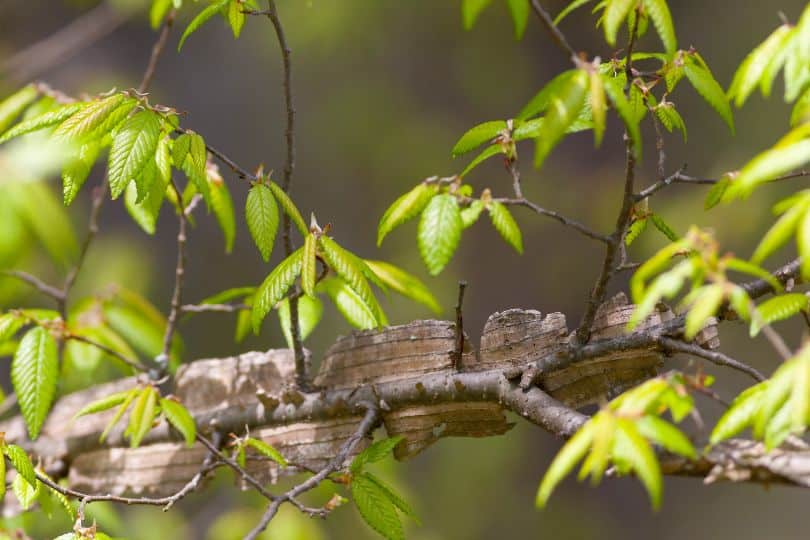
- Scientific Name: Ulmus alata Michx.
- Common Name(s): Winged Elm
- Mature Height: 40 to 50 feet (12 to 15 meters)
- Native Region: Eastern part of the State, extending west to Murray County, Oklahoma.
- Flowers: The flowers appear in early spring, before the unfolding of leaves.
- Fruit: The fruit ripens in the spring and is winged, oblong, reddish-brown, about one-third of an inch long, and covered with white hairs.
- Uses: The wood is heavy, hard, strong, and difficult to split, which makes it occasionally used for hubs and mauls.
The Winged Elm, scientifically known as Ulmus alata Michx., is a medium-sized tree that normally grows to be 40 to 50 feet tall, though it can occasionally grow larger. It receives its common name from the thin, corky growth, or wings, that are commonly found on its smaller branches, though these wings are frequently lacking in larger, fast-developing trees.
The Winged Elm’s bark is light brown with red flecks and is separated into irregular flat ridges and cracks.
This elm tree is native to eastern Oklahoma, stretching west to Murray County. It can be found on dry uplands on occasion, although it is usually found in moist soils beside streams and waste areas.
The Winged Elm is well-known for its quick growth in damp conditions, making it ideal for planting along roadsides in dry and impoverished areas. It is relatively disease-free, but it is not a particularly long-lived tree.
The Winged Elm’s leaves are simple and alternating, measuring 2 to 4 inches long and 1 to 2 inches wide. They have coarsely double-toothed upper surfaces that are dark green and smooth, while the lower surfaces are pale and softly downy. The leaves are short and pointed at the tip, which distinguishes them from the Cedar Elm’s little blunt leaves.
The Winged Elm produces little, inconspicuous blossoms in early spring before the leaves emerge. The tree’s fruit ripens in the spring, around the time the leaves emerge.
The fruit is winged, oblong, reddish-brown, and about one-third of an inch long, with white hairs covering it. It has two little incurved awns or beaks at the base, as well as a long, slender stalk.
The Winged Elm’s wood is comparable to that of other elm trees. It is heavy, hard, powerful, and difficult to split; therefore, it is only used for hubs and mauls on occasion. Historically, the inner bark of the tree was used to make ropes, notably to tie covers to cotton bales.
5. Red Elm
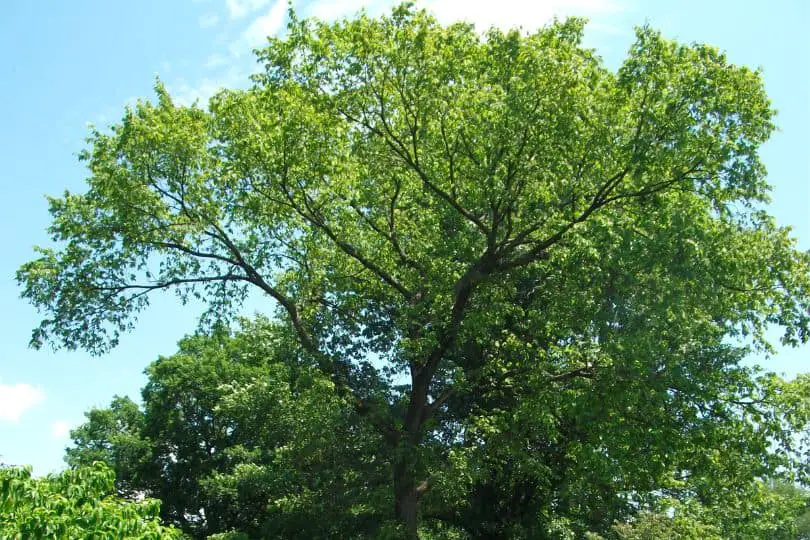
- Scientific Name: Ulmus serotina Sarg.
- Common Name(s): Red Elm, Black Elm
- Mature Height: It can reach a height of 70 feet or more.
- Native Region: Eastern part of Oklahoma.
- Flowers: The flowers of red elm appear in September.
- Fruit: The fruit of red elm resembles beggar’s lice but does not cling to one’s clothes.
- Uses: Red elm wood is used for lumber, veneer, and fuel.
The Red Elm, often known as the Black Elm, is a tree that is prevalent in eastern Oklahoma. It grows best in rocky shallow limestone soil, but it can also be found in deep bottom soil if disturbed by plowing. This elm species’ ancient growth has been considerably diminished due to frequent cutting, but it can still reach amazing sizes. It can grow to a diameter of 2 to 3 feet and a height of 70 feet or more in excellent soil.
The bark of the Red Elm is dark and separated into short flakes or strips, with occasional reddish tinges. The trunk of the tree is often 30 to 40 feet long and branchless before splitting into multiple sturdy spreading limbs. The branches form a large round-topped head with drooping branches that are often crimson.
The leaves of the Red Elm are simple and alternating, rectangular with narrow-pointed points. They have notched edges and are 2 to 4 inches long. The tree produces tiny blooms in September, and fruit follows them quickly. Red Elm fruit resembles beggar’s lice but does not stick to clothing.
Red Elm wood is hefty, durable, and strong, with a light brown color that is tinted with red. However, if used in the ground, it is prone to deteriorate. As a result, it is extensively used in the production of lumber, veneer, and fuel. Its timber is strong and may be used in a variety of construction projects, while the veneer is attractive. Red Elm is also an excellent source of firewood.
Red Elm can be a beautiful addition to gardens and landscapes in Oklahoma. It may grow in a variety of soil types but grows best in rocky shallow limestone soil. Its eye-catching round-topped head with hanging branches complements the landscape, especially when tinted with red. Regular care for Red Elm includes regular watering, pruning to keep its shape, and prevention against elm illnesses such as Dutch Elm Disease.
This native elm species may thrive and add to the beauty of Oklahoma gardens while also offering significant wood resources if properly cared for.
Similar Articles
- Native Pine Trees In Oklahoma
- Native Maple Trees In Oklahoma
- Common Palm Trees In Oklahoma
- Native Hickory Trees In Oklahoma
- Native Oak Trees In Oklahoma
- Native Cedar Trees In Oklahoma
- Common Cherry Trees In Oklahoma
- Native Ash Trees In Oklahoma
- Common Birch Trees In Oklahoma
- Native Cypress Trees In Oklahoma
Native Elm Trees In Oklahoma – Sources
The Regional Gardening team makes sure that the information in our articles is accurate by only using sources that are known to be trustworthy. Some of these sources are peer-reviewed journals from government agencies, well-known universities, and scientific research organizations.
- Forest Tree Species, Oklahoma State University Extension
- Oklahoma Trees for Gardening Resource, Oklahoma State University Extension
- Oklahoma Native Trees by County, Oklahoma Forestry Services
- Native Plant Guide, Oklahoma County Conservation District
- Plants, Seeds & Landscapes, Oklahoma Native Plant Society
- Plant Selections for Oklahoma, Oklahoma State University Extension


